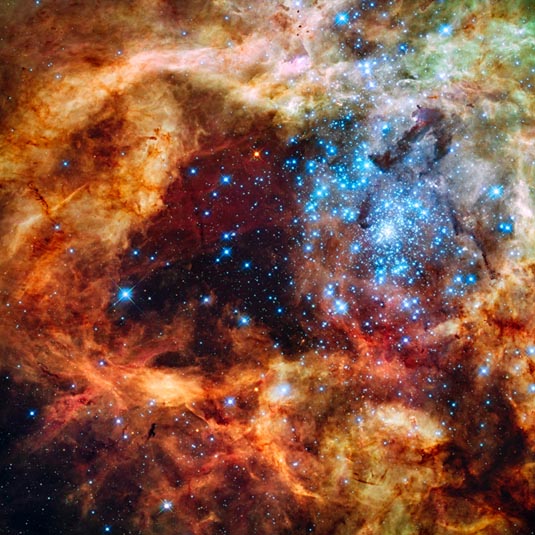
Grand Star-Forming Region
Description: Nebula in the Large Magellanic Cloud
Position (J2000): R.A. 05h 38m 42s Dec. -69° 06' 03''
Constellation: Dorado
Distance: 170,000 light-years (52,000 parsecs)
Instrument: WFC3/UVIS WFC/IR
Exposure Date(s): October 20-27, 2009
Exposure Time: 11.7 hours & 2.6 hours
Image Credit: NASA, ESA, and F. Paresce (INAF-IASF, Bologna, Italy), R. O'Connell (U of Virginia, Charlottesville), and the Wide Field Camera 3 Science Oversight Committee
Release Date: December 15, 2009
More images: N0650 N1023 N0401 N1105 N0121 N0416 N1117 S0932
ABOUT THIS IMAGE:
Just in time for the holidays: a Hubble Space Telescope picture postcard of hundreds of brilliant blue stars wreathed by warm, glowing clouds. The festive portrait is the most detailed view of the largest stellar nursery in our local galactic neighborhood.
The massive, young stellar grouping, called R136, is only a few million years old and resides in the 30 Doradus Nebula, a turbulent star-birth region in the Large Magellanic Cloud (LMC), a satellite galaxy of our Milky Way. There is no known star-forming region in our galaxy as large or as prolific as 30 Doradus.
Many of the diamond-like icy blue stars are among the most massive stars known. Several of them are over 100 times more massive than our Sun. These hefty stars are destined to pop off, like a string of firecrackers, as supernovas in a few million years.
The image, taken in ultraviolet, visible, and red light by Hubble's Wide Field Camera 3, spans about 100 light-years. The nebula is close enough to Earth that Hubble can resolve individual stars, giving astronomers important information about the stars' birth and evolution.
The brilliant stars are carving deep cavities in the surrounding material by unleashing a torrent of ultraviolet light, and hurricane-force stellar winds (streams of charged particles), which are etching away the enveloping hydrogen gas cloud in which the stars were born. The image reveals a fantasy landscape of pillars, ridges, and valleys, as well as a dark region in the center that roughly looks like the outline of a holiday tree. Besides sculpting the gaseous terrain, the brilliant stars can also help create a successive generation of offspring. When the winds hit dense walls of gas, they create shocks, which may be generating a new wave of star birth.
The movement of the LMC around the Milky Way may have triggered the massive cluster's formation in several ways. The gravitational tug of the Milky Way and the companion Small Magellanic Cloud may have compressed gas in the LMC. Also, the pressure resulting from the LMC plowing through the Milky Way's halo may have compressed gas in the satellite. The cluster is a rare, nearby example of the many super star clusters that formed in the distant, early universe, when star birth and galaxy interactions were more frequent. Previous Hubble observations have shown astronomers that super star clusters in faraway galaxies are ubiquitous.
The LMC is located 170,000 light-years away and is a member of the Local Group of Galaxies, which also includes the Milky Way.
The
Hubble observations were taken Oct. 20-27, 2009. The blue color is light
from the hottest, most massive stars; the green from the glow of oxygen;
and the red from fluorescing hydrogen.
Color: The images are composites of
separate exposures made by the WFC3 instrument on the Hubble Space Telescope.
Five filters were used to sample broad and narrow wavelength ranges for
the UVIS image. Two filters were used to sample broad wavelength ranges
from the IR image. The colors result from assigning different hues (colors)
to each monochromatic image. In this case, the assigned colors are:
WFC3/UVIS Image: F336W (U) &F438W (B) blue F555W
(V) green F814W (I) red F656N
(H-alpha) orange/red
WFC3/IR Image: F110W (J) cyan F160W (H) orange